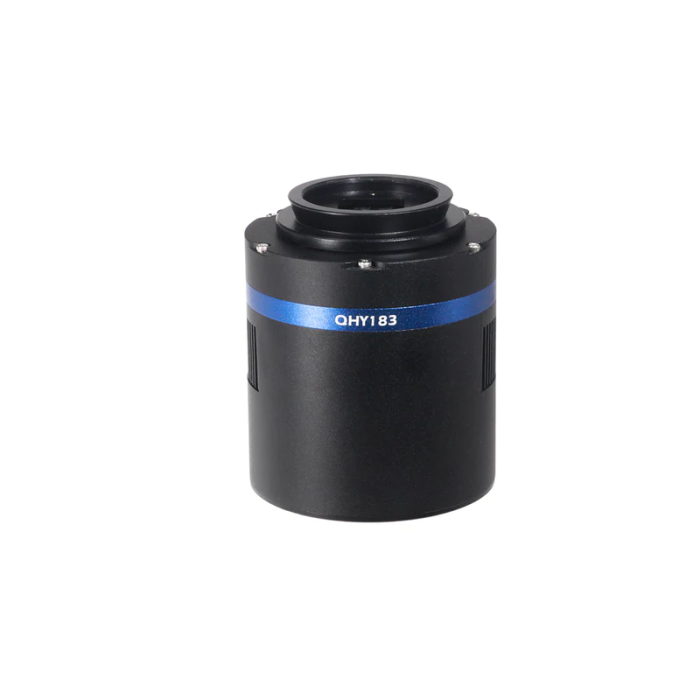كاميرا تلسكوب CMOS أحادية اللون QHY 183M المبردة
- سخان مضاد للندى: يمنع تشكل التكثيف وتراكم الجليد.
- دائرة مضادة لتوهج المكبِّر: تقلل من توهج المكبِّر عند التعريض الطويل.
- ذاكرة DDR سعة 128 ميجابايت: لتسريع أوقات التنزيل.
مقدمة
كاميرا QHY183M هي كاميرا مصممة خصيصًا للمبتدئين في التصوير الفلكي. تتمتع بحساسية عالية وضوضاء منخفضة، مما يجعلها مثالية لالتقاط صور مذهلة للسماء ليلاً.
المميزات
مستشعر 183 خلفي للإضاءة: يوفر حساسية أعلى ودقة أعلى من مستشعر الإضاءة الأمامية.
تبريد TEC ثنائي المراحل: يبرد المستشعر إلى -40 درجة مئوية تحت درجة حرارة الغرفة لتقليل ضوضاء التيار الداكن في التعرضات الطويلة.
تقنية Anti-Amp Glow: تقلل بشكل كبير من توهج مضخم CMOS النموذجي للحصول على معايرة ممتازة.
ميزات مضادة للضباب المدمجة: تمنع تكثيف الضباب وتشكل الصقيع على نافذة الغرفة.
منفذ توجيه معزول بصريًا: يسمح بإعداد توجيه سهل.
ذاكرة تخزين DDR2 بسعة 128 ميجابايت: تسرع من أوقات التنزيل.
واجهة USB 3.0: توفر نقل بيانات سريع.
مواصفات المستشعر
الحساس: Sony IMX183 BSI CMOS
حجم البكسل: 2.4 ميكرومتر × 2.4 ميكرومتر
البكسلات الفعالة: 20 ميجابكسل
ضوضاء القراءة: 2.7e- عند أدنى مستوى للإشارة، 1.0e- عند مستوى الإشارة العالي
تيار الظلام: 0.0024e-/بكسل/ثانية عند -15 درجة مئوية
نطاق وقت التعرض: 50 ميكروثانية - 3600 ثانية
سعة الاكتمال الكامل: 15.5 كيلو إلكترون
عمق أخذ العينات AD: 12 بت (إخراج كـ 16 بت و 8 بت)
اكتساب الصور
معدل الإطار الكامل الأقصى: 19 إطارًا في الثانية عند 8 بت، 7.5 إطارات في الثانية عند 12 بت
أحجام ROI المدعومة: يتم دعم دقة مختلفة
نوع الغالق: غالق رولنج الكهربائي
واجهة الكمبيوتر: USB 3.0
المواصفات المادية
الوزن: 650 جرام
طول البعد البؤري الخلفي: 17.5 مم
واجهة التلسكوب: M42/0.75
الملحقات والخيارات
عجلة مرشح CFW3S: يوصى بها للتصوير الكوكبي والفضاء العميق.
مجموعة محولات M42 الكل في واحد: توفر محولات ومسافات مختلفة لتكوينات التلسكوب المختلفة.
أنبوب سيليكا جل جاف: يمنع تراكم الرطوبة داخل الكاميرا.
البرامج والبرامج التشغيل
EZCAP_QT: برنامج التقاط الصور المطور بواسطة QHYCCD.
SharpCAP: برنامج فوتوغرافيا فلكي شائع.
برامج مدعومة بواسطة ASCOM: Maxim DL، The SkyX، وغيرها من حزم البرامج الداعمة لـ ASCOM.
QHYCCD BroadCast WDM Camera Driver: يسمح لك باستخدام الكاميرا مع برامج أخرى لبث الفيديو المباشر.
الصيانة
مستشعر CMOS: نظف المستشعر باستخدام مجموعة تنظيف مستشعرات كاميرات DSLR.
نافذة بصرية: نظف النافذة بقطعة قماش من الألياف الدقيقة.
مبرد TEC: تجنب الصدمة الحرارية عن طريق زيادة أو تقليل الطاقة تدريجيًا.
موارد إضافية
موقع QHYCCD: https://www.qhyccd.com/
دليل QHY183M: https://www.qhyccd.com/file/repository/PDF/CameraManual/QHY183C_Manual_EN.pdf




